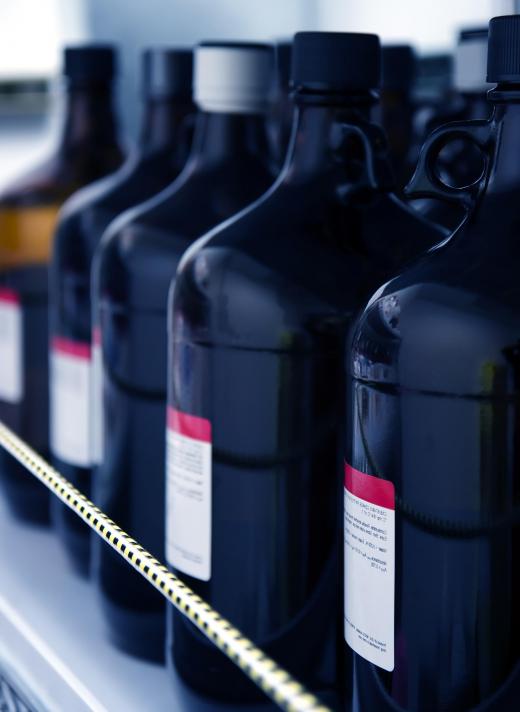What is Solution Polymerization?
Solution polymerization is used to create polymers and copolymers by dissolving a monomer and a catalyst in a non-reactive solvent. During this process, the solvent liquid absorbs the heat generated by the chemical reaction which controls the reaction rate. The liquid solvent used in the solution polymerization procedure usually remains a solvent for the resulting polymer or copolymer. This process is only suitable for the creation of wet polymer types, as the removal of excess solvent is difficult. While removal of excess solvent is possible using distillation, it is usually not considered economically possible in an industrial situation.
The process of solution polymerization offers a few advantages as well as one major disadvantage. The advantages include precise control of the chemical reaction, control of the resulting heat and viscosity, and control over auto acceleration of the process. The disadvantage of the process is the difficulty involved in the removal of excess solvent from the finished polymer.

The solvents used in the solution polymerization procedure must be chosen carefully. A solvent that is non-reactive to the monomer is essential to the process. If a reactive solvent is used, dangerous chain reaction processes or other undesirable effects can occur as a result of auto acceleration. Auto acceleration is a reaction that occurs when the heat produced by polymerization does not dissipated quickly enough by the solvent. As the heat builds up, the viscosity of the solution increases, causing the polymerization process to accelerate beyond safe control.

Industrial solution polymerization processes are commonly used to produce polymers with special characteristics. The chemical reaction that takes place between the monomer and catalyst can lend unique properties to the end product. One example of this type of polymer is sodium polyacrylate, the exceptionally absorbent polymer used in disposable diapers.
While this process is not generally feasible for dry polymers, it works well for wet polymer types. The process of industrial solution polymerization is used to create polymers and copolymers that can be used in their solution form. Examples of this usage include industrial glues and surface coatings.
Synthetic elastomers can also be produced using the solution polymerization process. This method produces a more precise polymer than emulsion polymerization methods. By controlling the addition of refined monomers to the catalyst-solvent solution, the resulting polymers can be carefully designed for specific properties. These synthetic elastomers are commonly found in products such as latex gloves, neoprene wetsuits and floor covering materials.
AS FEATURED ON:
AS FEATURED ON:












Discussion Comments
@Pelestears- The difference between emulsion and solution polymerisation is a bit difficult to explain in simple terms, but I will try. I will assume that you understand solution polymerization as explained in the article.
Emulsion polymerization is a free radical polymerization reaction that basically suspends one substance within another. Emulsion polymerization requires three basic components, a surfactant (think of a soap, basically the solution that the other monomer will be suspended in), a water soluble free radical initiator, and a monomer. The surfactant forms what are called micelles, which each have two ends of varying solubility. This allows the micelles to form a sort of theoretical net that traps the monomers within the clusters of micelles until a critical micelle concentration is reached.
The product of this reaction is called a latex, and is very similar to a latex paint. The polymer coating in a latex paint is made up of a base surfactant similar to a soap, combined with a monomer, and other substance to create the protective paint that you can put on your walls. It is a little difficult to understand, and you need to understand how a free-radical works, but I hope I was able to at least give you a vague understanding of how emulsion polymerization works.
@Pelestears- Polymers can include plenty of substances, including those made from hydrocarbons. Chitin, protein, and cellulose are natural polymers, and could potentially offer alternatives for hydrocarbon based plastics. There are already plastics on the market made form cellulosic feedstock like corn. These plastics are easier on the environment, and can be made from the cellulose and proteins inside of the plant.
Chitin is the other promising polymer that could make plastics one day. Chitin is found in organisms like shrimp, lobster, and crab shells. It is also an important part of other animals with exoskeletons. Chitin polymers have the capability to from hard plastics that can be reused over and over. These plastics would be renewable and would biodegrade much faster than current synthetic polymers.
Finally, the other possibility is to make synthetic polymers from other sources of carbon and hydrogen. Carbon is the most abundant element in our universe, and there are a number of ways to produce hydrogen, including by separating it from the oxygen in water.
What is emulsion polymerisation? How is emulsion polymerization different from solution polymerization? Is emulsion polymerization a chemical reaction that occurs to create a polymer? Are hydrocarbons the only type of substances that can be polymerized?
I always see those chemical commercials about the importance of plastic, and I began to wonder what will replace these substances when petroleum is no longer economically viable. Do we even have any plastic substitutes? Are there any type of synthetic polymers made from elements other than hydrogen and carbon?
It probably will not be for at least 100 years before we run out of oil, but how will we respond to not having hydrocarbons to create such critical materials like plastics? From what I understand, plastic can only be recycled a limited number of times before it can no longer be made into other plastics. I also learned that plastics actually change composition every time that they are recycled.
Post your comments